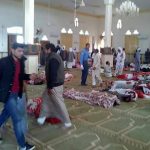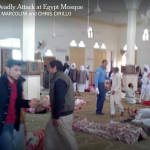By Abdel-Moneim Said – Al-Ahram Weekly
The US government has recently released to the public a large batch of documents that were recovered in the raid on Osama bin Laden’s compound in Abbottabad, Pakistan, in May 2011. What strikes one immediately, in these documents, is how the terrorist ideology that obsessed Bin Laden was rooted in Muslim Brotherhood ideology. The Al-Qaeda leader was steeped in the literature published by the Muslim Brotherhood’s founders and ideologues and he familiarised himself with their ideas directly through his contacts with Muslim Brotherhood leaders in Yemen.
This phenomenon is hardly unique among prominent terrorists and their organisations. The Muslim Brotherhood had always served as the “incubator” and the primary school in which terrorists take their first steps towards embracing extremist thought and its violent applications. Leaders of such organisations as Al-Gamaa Al-Islamiya and the Islamic Jihad in Egypt emerged directly from the folds of Muslim Brotherhood thought and practice. Among the star students were current Al-Qaeda chief Ayman Al-Zawahri, Mohamed Ata, who led that terrorist attack against the World Trade Center in New York on 11 September 2001, and the mastermind of the whole operation, Khaled Sheikh Mohamed. Although some of those individuals and organisations had their differences with the Muslim Brotherhood at some later juncture, their collective “jihadist” thought had its origins with the founders of the Muslim Brotherhood, whether in its first edition (Hassan Al-Banna) or its second edition (Sayed Qotb). While Qotb is always regarded as the father of contemporary terrorists, his ideas and outlooks can be traced to Al-Banna and the birth of the Muslim Brotherhood in 1928.
If the release of the Bin Laden documents takes us back again to the origins of extremist Islamist thought, it also reminds us that regardless of the notoriety that some terrorist organisations, such as Al-Qaeda and the Islamic State (IS) group, acquire from time to time, the Muslim Brotherhood remains the mother school. With branches spread across 81 countries, this organisation has managed to “institutionalise” its operations at the global level and to systematise it strategically, depending on whether it is experiencing a period of “weakness” or a period of “empowerment”, each requiring certain organisational, financial, economic, as well as military arrangements. But regardless of whether it is experiencing “weakness” or “empowerment”, the ideological and doctrinal regime remains the same. It is based on the concepts of hakimiya (divine sovereignty), unquestioning obedience, jihad and the inevitable confrontation with the “other”, meaning non-Muslims, all of which notions derive from the Kharijite creed. What this means is that, in spite of the victories against IS in Mosul and Raqqa and the imminent demise of the IS “caliphate”, terrorism and the ideas on which it is based will not disappear because the mother organisation still exists and remains capable of producing new terrorists and new terrorist organisations.
The concepts of “weakness” and “empowerment” are contingent on the balances of forces. When they are not favourable to the Muslim Brotherhood, the organisation assumes a façade of moderation and tolerance. This is the guise its branches assume in North America, the US and the West, in general, where Muslim Brotherhood leaders have succeeded in positioning themselves as representatives and spokesmen for Islam and the Muslim peoples. In the US, the Muslim Brotherhood controls almost all the societies and organisations that represent the Muslim in the US, such as the Islamic Society of North America, the Muslim Student Union, Muslim American Public Affairs Council, the American Society of Muslims and the Council on American-Islamic Relations. They also dominate the major mosques and Islamic centres. There, the Muslim Brotherhood projects messages that utilise such catchwords as democracy (under the banner of Shura, or consultation), human rights, civil society, equality and rejection of violence. Here, too, they conceal their real attitudes and intentions behind such rubric as “in a manner consistent with the principles of Islam” or “without contravening what is known to be obligatory under Islamic Law”. Such are the rhetorical loopholes that the Muslim Brotherhood has always used so as to be able to turn their stated positions on their head. We saw this in practice in Egypt at the time of the Muslim Brotherhood-controlled parliament in which their actual positions proved consistently opposed to civil liberties, full equality between citizens and, of course, women’s rights.
Whether in a state of “weakness” or “empowerment”, the Muslim Brotherhood is organised in a highly rigid, hierarchical structure similar to those of totalitarian fascist and communist regimes, with a military-like line of command and requiring unquestioning obedience and total secrecy. The structure is headed by a “Guidance Council” and a “Supreme Guide”, who has absolute powers, and a “Shura Council” that transmits the lower echelons’ views to the higher echelons. The secrecy, which was required in order to conceal the names of members and sources of finance, remained largely in place even after the Muslim Brotherhood acquired legitimacy following the January 2011 Revolution.
Another permanent feature of the organisation is its three arms: one financial, one for propaganda and one paramilitary. The financial arm, which has an international reach, collects money from members and investments, taking advantage of the tools of “globalisation” which the organisation probably condemns ideologically but which it uses anyway in order to conceal its financial resources and to move money as its ends require.
The propaganda arm starts with the famous Muslim Brotherhood logo: two inter-crossed swords above a Quran and the command “Be Prepared” written beneath. The logo reflects the Muslim Brotherhood’s outlook. They are in a perpetual state of war. Their swords remain unsheathed and their enemies are everywhere, requiring constant readiness to use armed force. But beyond symbols, they have an enormous propaganda machine, with press outlets, television stations, websites, news agencies, armies of social networking trolls and other means to wage psychological warfare.
The paramilitary arm had its origins in Egypt with the Muslim Brotherhood’s “Special Organisation” founded in the Hassan Al-Banna era. This underground wing came to public attention with the assassinations of prime minister Mahmoud Al-Noqrashi, judge Ahmed Al-Khazindar and the Cairo chief of police General Salim Zaki. The Muslim Brotherhood have sustained a continuous record of recourse to violence since then, in Egypt and elsewhere.
The international incubator and school for all terrorist movements does not confine itself to the educational and “proselytising” functions it performs through its numerous ideologues and media apparatuses. It also mobilises support for terrorism, justifies it and censures those who attempt to fight it. When terrorists are killed, in its eyes, they become “martyrs” who merit prayers and glorification. And when convenient, the Muslim Brotherhood does not hesitate to practise violence, as we see today in Egypt in the actions of the Hasm, Ajnad Misr, Al-Iqab Al-Thawri and other such Muslim Brotherhood affiliates, or they furnish financial and logistic assistance to other terrorist organisations.
The fight to uproot terrorism and extremism begins at its Muslim Brotherhood roots and with that organisation’s structure, doctrines, mobilisation and support mechanisms, and political and propaganda practices. Bin Laden and Al-Zawahri are not the first alumni of the Muslim Brotherhood school and they are unlikely to be the last.
The writer is chairman of the board, CEO and director of the Regional Centre for Strategic Studies.
__________________
Photo Credit: A Muslim Brotherhood rally in Syria – Wikipedia
http://weekly.ahram.org.eg/News/23056.aspx





